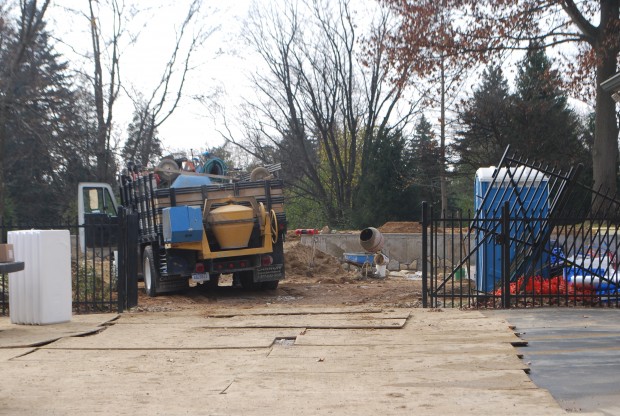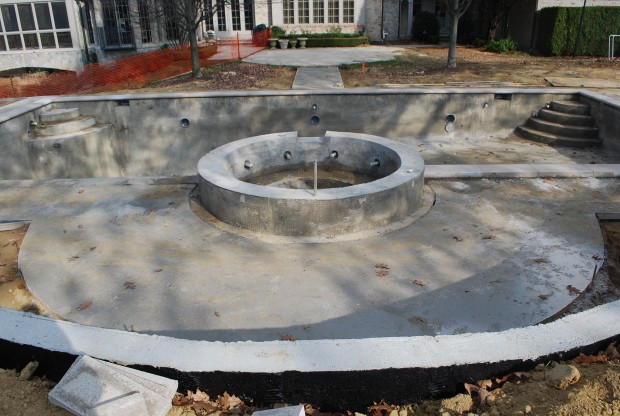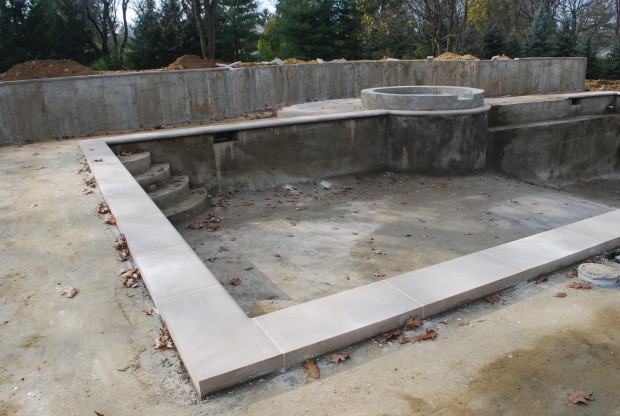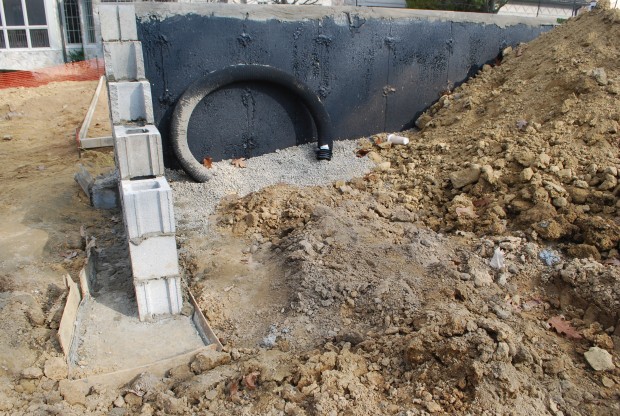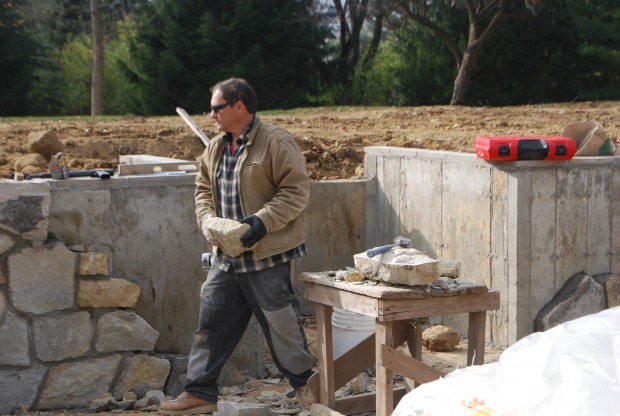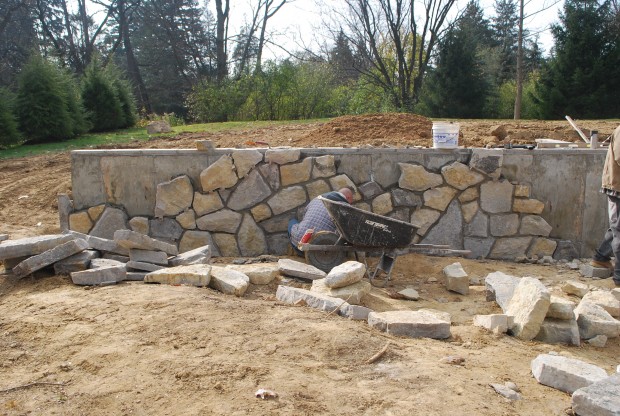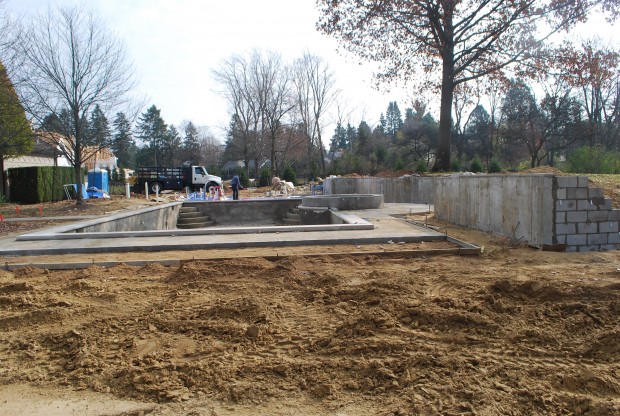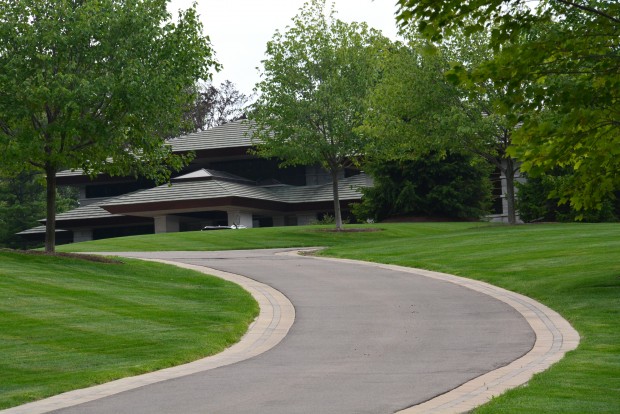 You may remember my post late last fall about the installation of 33 pinus flexilis. These trees were 10 feet tall, and had 36″ diameter root balls. We had to push them uphill with the help of an electric pallet jack, as the new driveway was not ready for vehicular traffic. The driveway you see in the picture above was slated to be replaced at the same time that the new landscape we designed would be installed. This sentence sounds benign, but the actual logistics were anything but. The installation of a landscape and a new driveway usually means a driveway first, and the landscape to follow. There are good reasons for this order of events. Any hard structure needs to come first. The grade of the driveway, terrace, or walk sets the grade of all else. The grade of the ground can be changed. The grade of a hard surface is a given. Decisions would be made about the proper planting level in advance of the drive being finished. That is a dicey proposition, especially when planting big trees.
You may remember my post late last fall about the installation of 33 pinus flexilis. These trees were 10 feet tall, and had 36″ diameter root balls. We had to push them uphill with the help of an electric pallet jack, as the new driveway was not ready for vehicular traffic. The driveway you see in the picture above was slated to be replaced at the same time that the new landscape we designed would be installed. This sentence sounds benign, but the actual logistics were anything but. The installation of a landscape and a new driveway usually means a driveway first, and the landscape to follow. There are good reasons for this order of events. Any hard structure needs to come first. The grade of the driveway, terrace, or walk sets the grade of all else. The grade of the ground can be changed. The grade of a hard surface is a given. Decisions would be made about the proper planting level in advance of the drive being finished. That is a dicey proposition, especially when planting big trees.
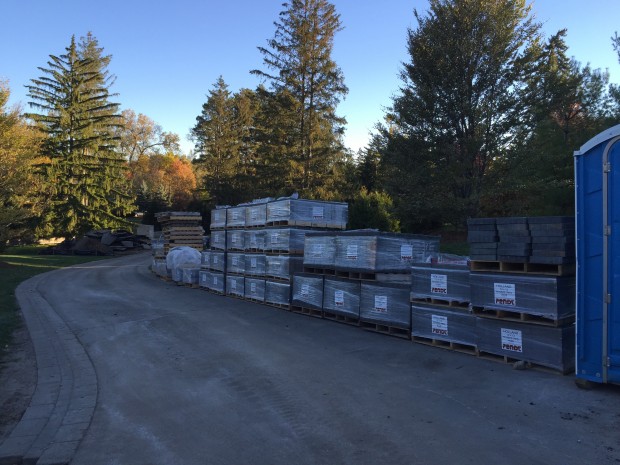 The installation of driveways, walks and terraces involve the placement and staging of lots of equipment and materials, none of which are so friendly to plants. We planted 5 large caliper beech just prior to the old drive removal. The new drive would be installed in 4 phases, and would take better than a month to complete. The rest of the large tree plantings would be worked in and around the phases of the drive. I knew there would be a limit to how long we could work outdoors. The long range forecast was calling for a very mild fall. I was hoping I could take that prediction to the bank. I had never installed a project of this size, in such a short amount of time, under such daunting circumstances.
The installation of driveways, walks and terraces involve the placement and staging of lots of equipment and materials, none of which are so friendly to plants. We planted 5 large caliper beech just prior to the old drive removal. The new drive would be installed in 4 phases, and would take better than a month to complete. The rest of the large tree plantings would be worked in and around the phases of the drive. I knew there would be a limit to how long we could work outdoors. The long range forecast was calling for a very mild fall. I was hoping I could take that prediction to the bank. I had never installed a project of this size, in such a short amount of time, under such daunting circumstances.
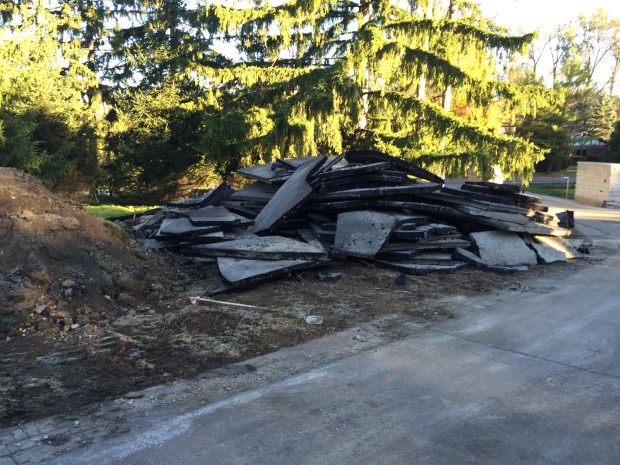 At this moment in late October, giant piles of old asphalt were waiting to be loaded up and hauled away. Pallet after pallet of new pavers were lined up along the side of the old drive. The lower portion of old driveway was still intact, so we hauled as much plant material to the top as we could. We coordinated with the driveway contractor. Wherever he was working, we would be working somewhere else.
At this moment in late October, giant piles of old asphalt were waiting to be loaded up and hauled away. Pallet after pallet of new pavers were lined up along the side of the old drive. The lower portion of old driveway was still intact, so we hauled as much plant material to the top as we could. We coordinated with the driveway contractor. Wherever he was working, we would be working somewhere else.
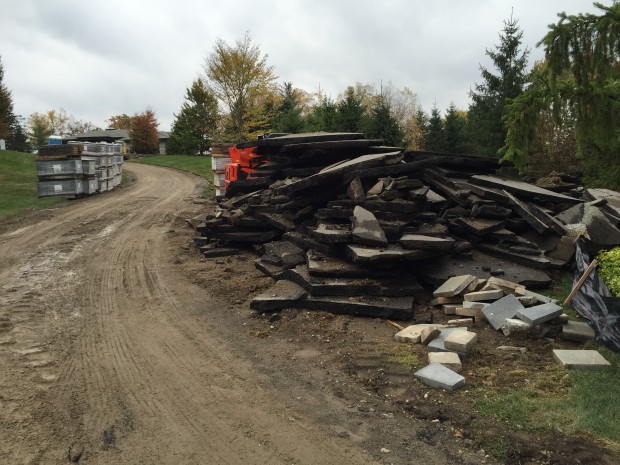 What these pictures do not show are the countless pieces of equipment and people involved in the project. Work was being done on the interior of the house. There was drainage work to be done. The irrigation system needed revamping. The landscape would be lighted, meaning there would be lots of conduit to be dug in.
What these pictures do not show are the countless pieces of equipment and people involved in the project. Work was being done on the interior of the house. There was drainage work to be done. The irrigation system needed revamping. The landscape would be lighted, meaning there would be lots of conduit to be dug in.
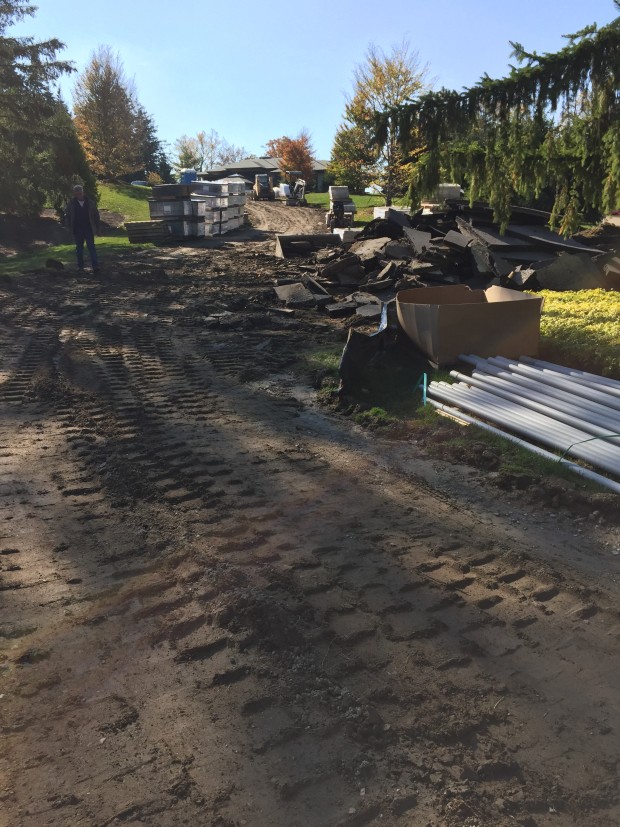 Removing an old driveway and installing a new one is a huge job. It turned out to be an incredibly good job. They were as organized and speedy as they could be. The job itself is beautiful. I will say that the day we could no longer use the drive presented serious challenges to our landscape installation. By this time, I was no longer able to drive my suburban to the job. I had to park on a sidestreet a block away, and walk up. Later on, I would hitch a ride with Dan. Her is a great landscape superintendent. He works along side his crew all day long, and has an unfailingly genial personality. He was able to sort things out with other contractors, even when tempers flared.
Removing an old driveway and installing a new one is a huge job. It turned out to be an incredibly good job. They were as organized and speedy as they could be. The job itself is beautiful. I will say that the day we could no longer use the drive presented serious challenges to our landscape installation. By this time, I was no longer able to drive my suburban to the job. I had to park on a sidestreet a block away, and walk up. Later on, I would hitch a ride with Dan. Her is a great landscape superintendent. He works along side his crew all day long, and has an unfailingly genial personality. He was able to sort things out with other contractors, even when tempers flared.
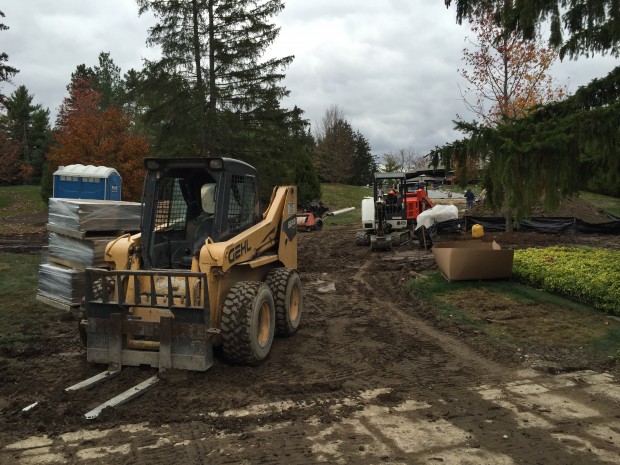 Once we were in to November, we had rain, and more rain. It became increasingly difficult to get from one place to another. You can barely see in the rear right of the above picture the new pale blue paver driveway advancing towards the road.
Once we were in to November, we had rain, and more rain. It became increasingly difficult to get from one place to another. You can barely see in the rear right of the above picture the new pale blue paver driveway advancing towards the road.
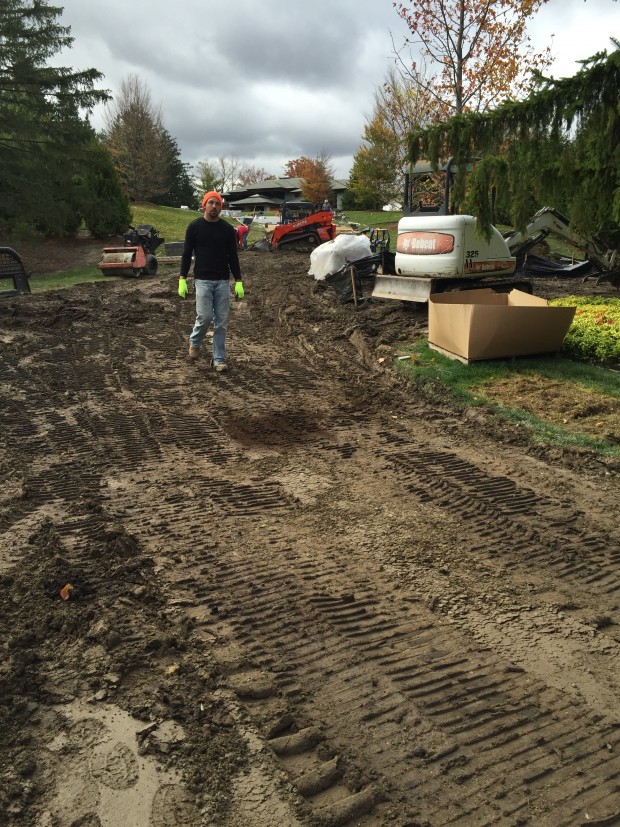 Mud and guts were the order of the day. I have never had to work someplace, in spite of having no way to get there. The project manager from the general contractor overseeing every aspect of the work both inside and out had a very big job. He is young and resourceful. His focus on moving every aspect of the project along in service to the finish was amazing to watch. From him I learned something new about the power of saying yes. And I told him so. A little appreciation can go a long way to mitigate a difficult situation.
Mud and guts were the order of the day. I have never had to work someplace, in spite of having no way to get there. The project manager from the general contractor overseeing every aspect of the work both inside and out had a very big job. He is young and resourceful. His focus on moving every aspect of the project along in service to the finish was amazing to watch. From him I learned something new about the power of saying yes. And I told him so. A little appreciation can go a long way to mitigate a difficult situation.
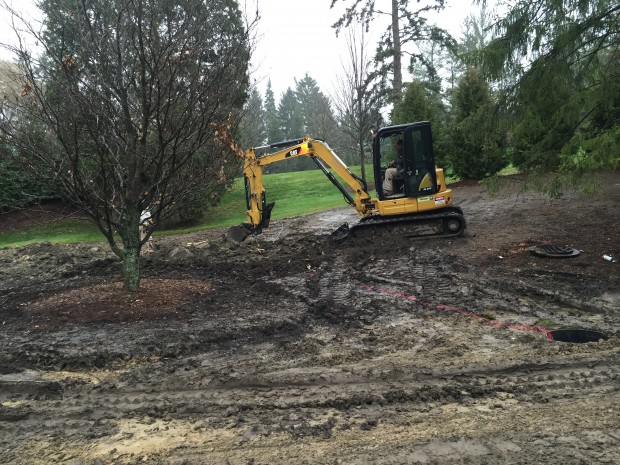 After Thanksgiving, the job has become a mud spectacle the likes of which I have I have never seen. The weather was bearable, but moving steadily towards the chilly side. The lowest spot in the yard had a series of drains installed. With a project like this, it is better to plan for the worst case, than wait and see if a problem develops. The big beech you see here had only been in the ground 2 months. The grading around the tree, and the attendant drainage system would protect the tree.
After Thanksgiving, the job has become a mud spectacle the likes of which I have I have never seen. The weather was bearable, but moving steadily towards the chilly side. The lowest spot in the yard had a series of drains installed. With a project like this, it is better to plan for the worst case, than wait and see if a problem develops. The big beech you see here had only been in the ground 2 months. The grading around the tree, and the attendant drainage system would protect the tree.
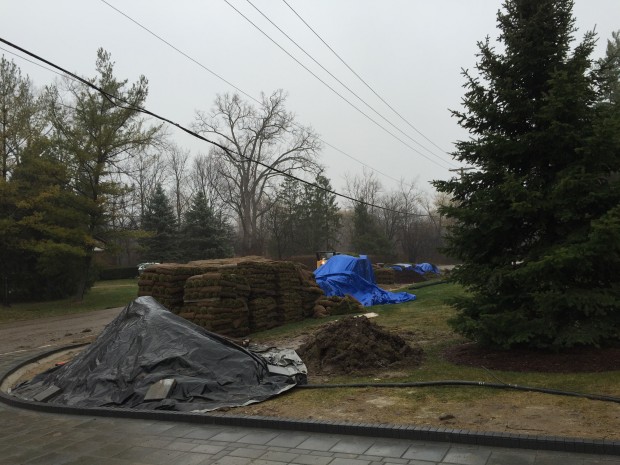
Eventually the driveway was finished. The task of repairing all of the collateral damage to the property that came with rebuilding the drive was just beginning.
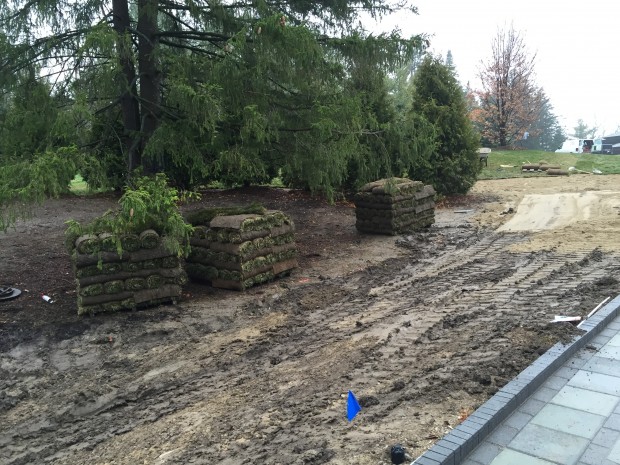 Regrading sopping wet clay based soil is next to impossible. Rather than make a bigger mess of what was already a hopping mess, the sod contractor brought in truckloads of sand. Sand gives up its water instantly, and can be graded and smoothed out. The old sod was stripped off at least 30 feet either side of the finished drive. Sand was added to produce a smooth surface and graceful slope to the drive that was not too high, nor too low.
Regrading sopping wet clay based soil is next to impossible. Rather than make a bigger mess of what was already a hopping mess, the sod contractor brought in truckloads of sand. Sand gives up its water instantly, and can be graded and smoothed out. The old sod was stripped off at least 30 feet either side of the finished drive. Sand was added to produce a smooth surface and graceful slope to the drive that was not too high, nor too low.
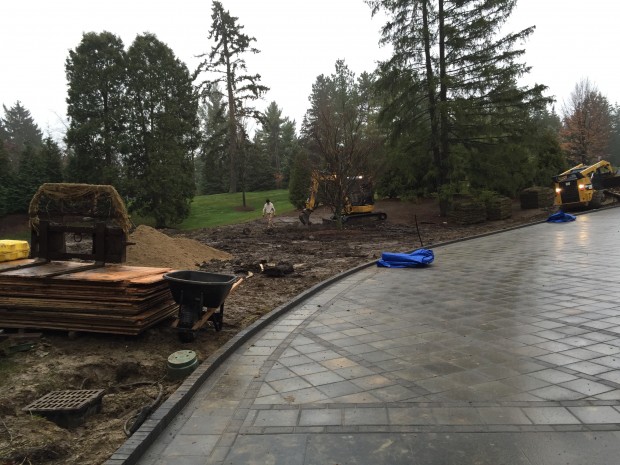 By late November, the only vehicles that could navigate the ground were track powered machines. Anything with wheels would sink in up to their axles. Luckily, these areas that had sustained such heavy and frequent compaction to the soil from machines would be planted with grass.
By late November, the only vehicles that could navigate the ground were track powered machines. Anything with wheels would sink in up to their axles. Luckily, these areas that had sustained such heavy and frequent compaction to the soil from machines would be planted with grass.
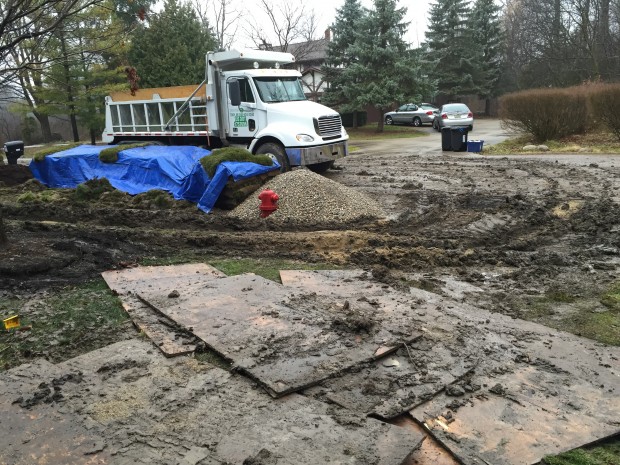 All of the landscape machines had to use an alternate route into the yard, since the driveway was unavailable. This is the scene at the road on December 2nd. A scene it was. Plywood was covering a staging area for trees. A truckload of gravel had been delivered to fill the drainage ditches. And of course, the many yards of sod waiting to be put down. Needless to say, the general contractor had the street cleaned every day for several weeks.
All of the landscape machines had to use an alternate route into the yard, since the driveway was unavailable. This is the scene at the road on December 2nd. A scene it was. Plywood was covering a staging area for trees. A truckload of gravel had been delivered to fill the drainage ditches. And of course, the many yards of sod waiting to be put down. Needless to say, the general contractor had the street cleaned every day for several weeks.
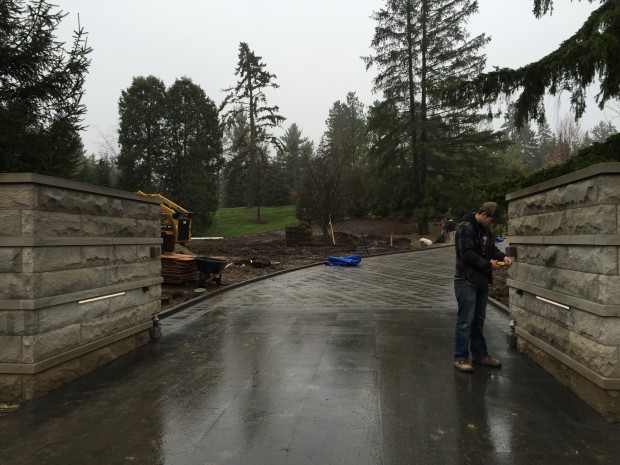 It was a happy day indeed, when the driveway reopened in mid December. By this time, most of the large trees and evergreen shrubs slated for the landscape were in the ground. The last of the grading and sod would go quickly. As it turned out, we finished the last of the mulching and gravel the first week of January. I was just there this past week. All of the plants look great. I owe it all to a very long fall, and a mild winter. The landscape portion of this project-I will post about that part next.
It was a happy day indeed, when the driveway reopened in mid December. By this time, most of the large trees and evergreen shrubs slated for the landscape were in the ground. The last of the grading and sod would go quickly. As it turned out, we finished the last of the mulching and gravel the first week of January. I was just there this past week. All of the plants look great. I owe it all to a very long fall, and a mild winter. The landscape portion of this project-I will post about that part next.
